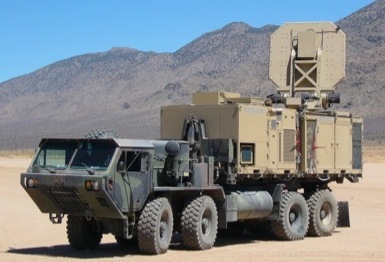

Army Orders Pain Ray Trucks; New Report Shows 'Potential for Death'
By David Hambling
After years of testing, the Active Denial System -- the pain ray which drives off rioters with a microwave-like beam -- could finally have its day. The Army is buying five of the truck-mounted systems for $25 million. But the energy weapon may face new hurdles, before it's shipped off to the battlefield; a new report details how the supposedly non-lethal blaster could be turned into a flesh-frying killer. The contract for the pain ray trucks is "expected to be awarded by year's end," Aviation Week notes. "A year after the contract is signed, the combination vehicle/weapons will start be fielded at the rate of one per month."
It's been a very long time coming. As we've previously reported, there have been calls to deploy the Active Denial System in Iraq going back to 2004. But it's always been delayed for legal, political, and public relations reasons. Anything that might be condemned as torture is political dynamite. Interestingly, the version being bought is not the full-size "Version 2," but a containerized system known as Silent Guardian, which Raytheon have been trying to sell for some time. They describe Silent Guardian as "roughly 1/3 the size and power of the other Active Denial Systems," and quote it's range as "greater than 250 meters." The larger system has a range somewhere in excess of 700 meters. Silent Guardian weighs a shade over 10,000 pounds all up, and will be mounted on an "armored ruggedized HEMTT [Heavy Expanded Mobility Tactical Truck]." The announcement arrives on the same day as a new report from less-lethal weapons expert Dr. Jürgen Altmann that analyzes the physics of several directed energy weapons, including Active Denial, the Advanced Tactical Laser (used as a non-lethal weapon), the Pulsed Energy Projectile (a.k.a. "Maximum Pain" laser) and the Long Range Acoustic Device (a.k.a. "Acoustic Blaster"). Dr. Altmann describes the Active Denial beam in some detail, noting that it will not be completely uniform; anyone unlucky enough to be caught in the center will experience more heating than someone at the edge. And perhaps more significant is his thorough analysis of the heating it produces -- and the cumulative effect if the target does not have the chance to cool down between exposures. In U.S. military tests, a fifteen-second delay between exposures was strictly observed; this may not happen when the ADS is used for real. "As a consequence, the ADS provides the technical possibility to produce burns of second and third degree. Because the beam of diameter 2 m and above is wider than human size, such burns would occur over considerable parts of the body, up to 50% of its surface. Second- and third-degree burns covering more than 20% of the body surface are potentially life-threatening -- due to toxic tissue-decay products and increased sensitivity to infection -- and require intensive care in a specialized unit. Without a technical device that reliably prevents re-triggering on the same target subject, the ADS has a potential to produce permanent injury or death. " This potential hazard need not be a show-stopper -- existing less-lethals, such as plastic bullets and tear gas, can also be fatal under some circumstances (and I'm not even going to get into the argument about Tasers). Dr. Altmann notes that "the present analysis has not found convincing arguments that the ADS would be immoral or illegal in each foreseeable circumstance," and that acceptance will depend very much on how it is used. If the ADS prevents small boats from approaching a U.S. vessel without harming anyone, then it will be seen as a humane option. If it is used to clear protesters out of the way it may be seen differently. Meanwhile, the National Institute of Justice is still has a reported interest in a "hand-held, probably rifle-sized, short range weapon that could be effective at tens of feet for law enforcement officials." That's just one of the likely domestic applications of Active Denial technology which are likely to follow if the Army's experiment with ADS is successful. A lot of people will be watching this one very closely.
|